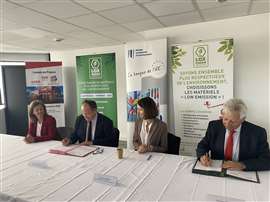Banking on Europe: Why the EIB is backing rental firms with cheap loans
26 February 2024
Since 2017, the European Investment Bank has provided five European rental firms with a total of more than €300m of cheap loans to invest in ‘greening’ their fleets. Lucy Barnard asks why the lending arm of the EU is writing loans to rental firms - and what sort of equipment can they buy with them?
In a world where banks are facing increasing scrutiny over their lending, the European Investment Bank, the lending arm of the European Union, must make some difficult choices.
The Luxembourg-based bank, which was founded in 1958 with a mandate to lend in the public interest, providing loans to projects and regions which might otherwise struggle to win backing from commercial financiers, is jointly owned by the EU’s 27 member states.
Over the last 66 years, the bank has mushroomed, growing to become the biggest public development bank in the world – even larger than the World Bank and providing loans touching all walks of life from the European Galileo satellite navigation system to the BionTech covid vaccine development.
 Nathalie Climence, head of corporate financing for the European Investment Bank in France, Ireland and Benelux. (Photo: EIB)
Nathalie Climence, head of corporate financing for the European Investment Bank in France, Ireland and Benelux. (Photo: EIB)
In recent years the bank has grown even more in political importance as cash-strapped EU countries have tapped into it to fund investments.
“The EIB supports projects that make a significant contribution to growth, employment, regional cohesion and environmental sustainability, in Europe and beyond,” Nathalie Climence, head of corporate financing for the European Investment Bank in France, Ireland and Benelux, tells IRN.
“EIB can support all sizes of companies that seek financing for investment projects aligned with EU policy priorities.”
As a not-for-profit organization backed by 27 sovereign countries, the banks enjoys an AAA credit rating, allowing it to borrow money cheaply on the international markets and lend it at extremely low interest rates over long periods of time. The bank has a balance sheet total of €544bn and a subscribed capital of €249bn.
Since the turn of the century the bank has also been coming under increasing pressure to finance projects in line with the EU’s efforts to tackle climate change. By 2025, the bank says it wants half of its lending activity to support ‘green’ projects, to help leverage €1trn of investment by 2030.
In 2019, it announced it was phasing out lending to fossil fuel projects and in 2021 it tightened that to stop any lending to polluting companies that want to finance low carbon projects and in 2022, went a step further, announcing more stringent tests for road infrastructure projects.
Becoming a ‘climate bank’
“The EIB was the first multilateral bank to consider not just the climate impact of the projects it finances but also the wider activity of borrowers,” Climence says. “We ensure that projects financed by the EIB are not only aligned with the Paris Agreement but also that the party taking out the loan is taking steps towards decarbonizing business activity and strengthening resilience to climate change.”
It is against this background that in recent years, construction equipment rental companies have been among the beneficiaries of EIB lending as part of its drive to support decarbonization and circularity.
 The Loxam management team and EIB representatives sign a €130 million loan agreement in 2022. Pictured left, Ambroise Fayolle, EIB Vice-President; pictured right, Gérard Déprez, CEO of the Loxam Group. (Photo: Loxam)
The Loxam management team and EIB representatives sign a €130 million loan agreement in 2022. Pictured left, Ambroise Fayolle, EIB Vice-President; pictured right, Gérard Déprez, CEO of the Loxam Group. (Photo: Loxam)
In 2017, the bank signed two €50 million loans with Finnish plant hire specialists Ramirent (now part of Loxam) and Cramo (now part of Boels) to improve the performance and environmental impact of their fleets.
Then, in 2022, the bank signed a €130m loan with French equipment hire giant Loxam to accelerate the electrification and greening of its fleet, another €35m loan to Spanish rival GAM to support electric rental fleets, and a €50m loan with Dutch firm Collé Rental & Sales to be put towards the further expansion and electrification of its fleet.
For their part, European rental companies are thrilled to be getting loans from the AAA rated organization.
“This funding is a tremendous recognition of the quality of work Loxam has undertaken for many years to place CSR at the heart of its development model,” said Gérard Déprez, Loxam chief executive.
“With this loan, we will be able to continue and speed up the implementation of our carbon reduction commitments, thereby strengthening our role as leader in moving our entire sector towards a more responsible model.”
It’s a sentiment echoed by GAM’s chief financial officer, Antonio Trelles. “This loan diversifies our sources of funding and will help us expedite our plans to minimize GAM’s CO2 emissions, one of our strategic priorities,” he says. “We greatly appreciate the EIB’s faith in our company, which will enable us to pursue our digitization strategy and, of course, enhance our commitment to sustainability and to society.”
Climence says that these loans to construction equipment rental firms fall very much within the EIB’s current lending mandate.
Supporting EU policy priorities
“The use of EU debt funding in our projects that you mention is good as long as it supports the policy priorities of the Commission which is, in these cases, to focus on decarbonization and circular economy,” she says. “The fleet electrification and substitution of fossil-fuelled equipment with zero/low emission equipment will help to reduce the specific energy consumption, avoid exhaust emissions, reduce noise emissions and reduce pollution by oils and lubricants during operation and maintenance.”
Nonetheless, in recent years the EIB has been coming under increasing pressure from critics who say that the bank’s climate pledges do not stand up to scrutiny.
In 2022, the EU Ombudsman asked the bank to improve transparency around the projects it finances after NGOs ClientEarth, CEE Bankwatch Network and Counter Balance raised concerns that EIB claims that it dedicated €27.6bn to climate action and sustainability projects in 2021 could not be independently verified.
The NGOs complained that the EIB had not provided enough information about the projects it finances directly, the projects it finances via intermediaries, or given access to the minutes of its management committee, for them to be able to check that the bank had indeed dedicated €27.6bn to projects that it could classify as climate action and sustainability projects.
 Spanish economist and politician Nadia Calviňo became president of the EIB in January 2024. (Photo: Oscar Gonzalez/Reuters)
Spanish economist and politician Nadia Calviňo became president of the EIB in January 2024. (Photo: Oscar Gonzalez/Reuters)
“We want to know the details of the environmental impacts of the projects the EIB plans to fund, how it is assessing them and what it is doing about them,” said Sebastian Bechtel, ClientEarth senior law and policy advisor. “This is crucial information to be able to verify whether the EIB is actually being the climate bank it claims it is and to hold it accountable, if necessary.”
So. Just how ‘green’ are the EIB’s loans to rental companies?
According to EIB documents, the Loxam multi-annual investment plan covers “new state-of-the-art electric equipment and a small share of other ‘low emission’ biofuel- and hydrogen-powered equipment for the substitution of fossil fuel-powered polluting and CO2-emitting rental equipment and rental fleet renewal in France.”
Loxam says its plan is to “direct 50% of CapEx towards low emissions equipment by 2025.” However, there appears to be nothing in the agreement preventing the company from spending the other 50% of its expenditure on fossil fuel-based machinery and little to define ‘low emissions’ equipment.
Climence points out that an EIB team of engineers, economists and financial analysts carries out a project appraisal for each direct loan the bank agrees. Borrowers are then required to make regular reports to the bank for as long as the loan is running to check that they are spending the money on the things they have agreed.
“There is a reporting obligation in our finance contract on the utilization of our loans and as well as the carbon impacts,” she says.
What equipment can the loans be used to buy?
When asked directly if the bank has a specific definition it uses to assess ‘low emissions’ equipment or whether borrowers could use the money to buy less polluting equipment such as a stage V diesel generator, Climence says: “Regarding the eligibility of the different parts of an investment project, these items will be verified by our technical team during the appraisal process. The bank does not invest in unabated fossil fuel projects.”
Climence points out that the EIB lends to a whole range of borrowers from down to tiny startups. In practical terms, however, EIB funding to SMEs is handled via a long list of financial intermediaries throughout the EU and beyond, and only mid-caps and larger firms looking to borrow €40m-€50m are dealt with directly by the bank.
Borrowers can be based anywhere in the world although 90% of the EIB’s lending is within the EU.
In January 2024, Spanish economist and politician Nadia Calviňo became president of the EIB, taking over from German banker Werner Hoyer after 12 years and becoming the first woman to lead the institution, leading some analysts to hope that the change signals a new era of openness for the bank.
“Calviño must ensure that the Bank adopts strict environmental and social criteria for companies and financial institutions it works with,” says Frank Vanaerschot, director of Counter Balance, an NGO which campaigns for greater transparency and accountability within European public banks.
“This includes taking serious steps to improve transparency and accountability, such as a standard and timely disclosure of environmental and social assessments for all projects in line with the recommendations of the European Ombudsman.”
STAY CONNECTED



Receive the information you need when you need it through our world-leading magazines, newsletters and daily briefings.
CONNECT WITH THE TEAM








